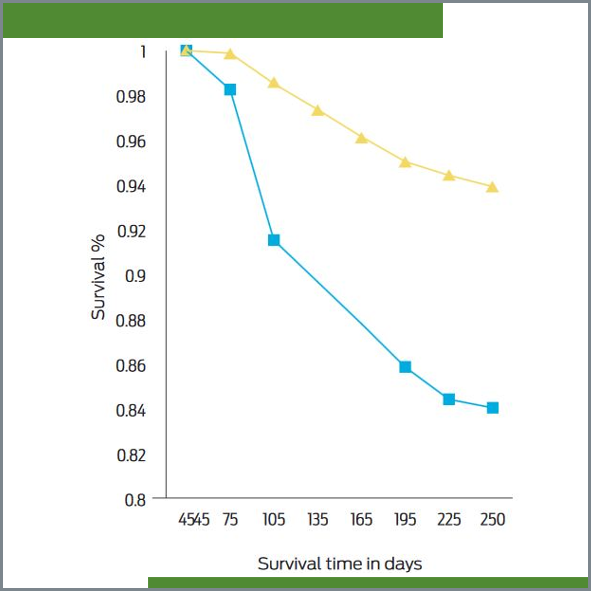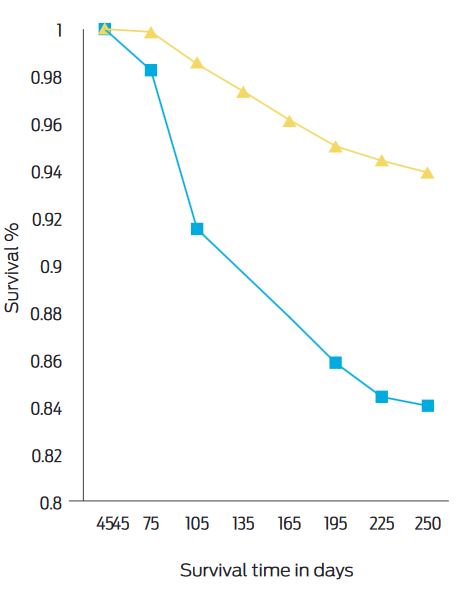Economic impact of pregnancy loss in an intensive dairy farming system
Contenido principal del artículo
Resumen
ISSN: 2448-6760
Cite this as:
- Albuja C, Hernández-Cerón, Joel, Ortiz O, López C. Economic impact of pregnancy loss in an intensive dairy farming system. Veterinaria México OA. 2019(1). doi: 10.22201/fmvz.24486760e.2019.1.572.
Occurrence of pregnancy loss and the related economic impact were determined in an intensively managed dairy herd. A total of 3,204 cow and heifer pregnancies were included over a two year period. Pregnancy loss was considered when: (1) cows or heifers that were diagnosed as pregnant by transrectal palpation, on days 50 to 50 postinsemination returned to estrus; (2) animals were found not to be pregnant at diagnosis confirmation on day 90, day 180, or during the drying-off period; and (3) if an abortion was clinically diagnosed. Data were analyzed through descriptive epidemiology and by survival analysis with the Kaplan-Meier method. The estimated cost of a single pregnancy loss was determined by the Monte Carlo methodology. Overall, 17.2% of cows (372/2,162) and 6.5% of heifers (68/1,042) had pregnany losses; the greater risk being in the first 90 days of gestation for cows (5.3/100 and 8.3/100 pregnancies in 2012 and 2013, respectively). Occurrence of pregnancy loss in heifers was also higher during the first trimester of gestation (1.7/100) in 2013. However, the pregnancy loss incidence peaked, between days 120 and 150 of gestation (1.7/100) in 2012. The cost of a single pregnancy loss during the first trimester was estimated at $5,253.00 (Mexican pesos), between days 91 and 180 at $9,674.00; and for over 181 days at $21,984.00. In conclusion, overall pregnancy loss rate in the studied herd was 17.2% for cows and 6.5% for heifers. The highest incidence of pregnancy loss occurred during the first 90 days of pregnancy. Thus, pregnancy loss may be the main reproductive cause affecting profitability of intensive dairy farming systems.
Detalles del artículo
Citas
Moore, DA, Overton NW, Chebel RC, Truscott ML, BonDurant RH. Evaluation of factors that affect embryonic loss in dairy cattle. J Am Vet Med Assc. 2005; 226:1112-8.
López-Gatius F, Almeria S, Serrano-Pérez B, Garcia-Ispiert O. Managing gestation in cattle. Anim Reprod. 2013;10:252-7.
Lee JE, Kim LH. Pregnancy loss in dairy cows: the contributing factors, the effects on reproductive performance and the economic impact. J Vet Sci. 2007;8:283-8.
Gädicke P, Monti G. Aspectos epidemiológicos y de análisis del síndrome de aborto bovino. Arch Med Vet. 2008;40:223-34.
Carpenter TE, Chrie lM,. Andersen MM, Wulfson L, Jensen AM, Houe H, et al. An epidemiologic study of late-term abortions in dairy cattle in Denmark, July 2000– August 2003. Prev Vet Med. 2006;77:215-29.
Meléndez RM, Valdivia AG, Rangel EJ, Aparicio EA, Segura-Correa JC, Guerrero AL. Factores de riesgo asociados a la presencia de aborto y desempeño repro¬ductivo en ganado lechero de Aguascalientes, México. Rev Mex Cienc Pecu. 2010;1:391-401.
Mellado M, López R, De Santiago Á, Veliz FG, Macías-Cruz U, Avendaño-Reyes L, et al. Climatic conditions, twining and frequency of milking as factors affecting the risk of fetal losses in high-yielding Holstein cows in a hot environment. Trop Anim Health Prod. 2016;48:1247-52.
De Vries A. Economic value of pregnancy in dairy cattle. J Dairy Sci. 2006;89:3876-85.
Liang D, Arnold LM, Stowe CJ, Harmon RJ, Bewley JM. Estimating US dairy clinical disease costs with a stochastic simulation model. J Dairy Sci. 2017;100:1472-86.
Bech-Sàbat G, García-Ispierto I, Yániz J, López-Gatius F. Therapeutic approaches to pregnancy loss of non-infectious cause during the late embryonic/early foetal period in dairy cattle. A review. Reprod Domest Anim. 2010;45:469-75.
López-Gatius F. Factors of a noninfectious nature affecting fertility after artificial in¬semination in lactating dairy cows. A review. Theriogenology. 2012;77:1029-41.
Wiltbank MC, Baez G, Garcia-Guerra A, Toledo MZ, Monteiro PLJ, Melo LF, et al. Pivotal periods for pregnancy loss during the first trimester of gestation in lactating dairy cows. Theriogenology. 2016;86:239–53.
López-Gatius F, Santolaria P, Yaniz J. Rutllant, López-Bejar M. Factors affecting pregnacy loss from gestation Day 38 to 90 in lactating dairy cows from a single herd. Theriogenology. 2002;57:1251-61.
Givens MD, Marley MSD. Infectious causes of embryonic and fetal mortality. Theriogenology. 2008;70:270-85.
Ahmadzadeh A, Frago F, Shafii B, Dalton JC, Price WJ, McGuire MA. Effect of clinical mastitis and other diseases on reproductive performance of Holstein cows. Anim Reprod Sci. 2009;112:273-82.
Dochi O, Kabeya S, Koyama H. Factors affecting reproductive performance in high milk-producing Holstein cows. J Reprod Dev. 2010;56 Suppl:S61-5.
Hazel AR, Heins BJ, Seykora AJ, Hansen LB. Production, fertility, survival, and body measurements of Montbéliarde-sired crossbreds compared with pure Holsteins during their first 5 lactations. J Dairy Sci. 2014;97:2512-25.
Cabrera VE. A simple formulation and solution to the replacement problem: a practical tool to assess the economic cow value, the value of a new pregnancy, and the cost of a pregnancy loss. J Dairy Sci. 2012;95:4683–98.
License

Veterinaria México OA por Facultad de Medicina Veterinaria y Zootecnia de la Universidad Nacional Autónoma de México se distribuye bajo una Licencia Creative Commons Atribución 4.0 Internacional.
Basada en una obra en http://www.revistas.unam.mx
- Todos los artículos en Veterinaria México OA se publican bajo una licencia de Creative Commons Reconocimiento 4.0 Unported (CC-BY 4.0). Con esta licencia, los autores retienen el derecho de autor, pero permiten a cualquier usuario compartir, copiar, distribuir, transmitir, adaptar y hacer uso comercial de la obra sin necesidad de proporcionar un permiso adicional, siempre y cuando se otorgue el debido reconocimiento al autor o fuente original.
- Al utilizar esta licencia, los artículos en Veterinaria México OA cubren o exceden todos los requisitos fundacionales e institucionales para ser considerados de Acceso Abierto.
- Los autores no pueden utilizar material protegido por derechos de autor en su artículo a menos que ese material esté también disponible bajo una licencia igualmente generosa.





